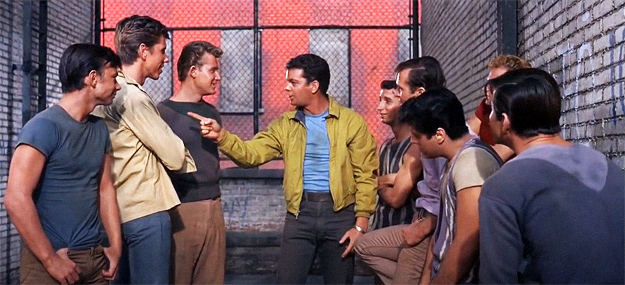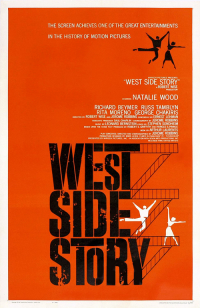“West Side Story stands as a prime example of successfully rendering a stage musical in cinematic terms.” – Matthew Kennedy, author of Roadshow!
The Digital Bits and History, Legacy & Showmanship are pleased to present this retrospective commemorating the 60th anniversary of the release of West Side Story, Robert Wise (The Sound of Music, Star!) and Jerome Robbins’ (The King and I, Gypsy) screen adaptation of the popular musical stage production inspired by Shakespeare’s Romeo and Juliet and starring Natalie Wood (Rebel Without a Cause, Brainstorm) as Maria and Richard Beymer (The Diary of Anne Frank, Twin Peaks) as Tony.
The winner of ten Academy Awards including Best Picture, the most popular movie of 1961 and one of the most popular musicals ever also featured Russ Tamblyn (Seven Brides for Seven Brothers) as Riff, Rita Moreno (The King and I) as Anita, and George Chakiris (The Young Girls of Rochefort) as Bernardo. [Read on here...]
In 1997 the Library of Congress selected West Side Story for preservation in the National Film Registry as being “culturally, historically or aesthetically significant.” Its most recent home media release (on Blu-ray Disc) was in 2011.

For the occasion of the film’s recent anniversary, The Bits features a multi-page article consisting of a Q&A with a trio of roadshow and musical authorities who reflect on the film, plus box-office data and statistics, passages from film reviews, and a reference listing of its theatrical roadshow presentations.
WEST SIDE NUMBER$
- 1 = Number of cinemas playing the film during its opening weekend
- 1 = Rank among top-earning films released in 1961 (lifetime/retroactive)
- 1 = Rank among top-earning films during the 1962 calendar year
- 2 = Box-office rank among films directed by Robert Wise (adjusted for inflation)
- 2 = Rank among UA’s all-time top-earning films at close of first run
- 2 = Rank on AFI’s Greatest Movie Musicals
- 5 = Peak all-time box-office chart position
- 10 = Number of Academy Awards
- 11 = Number of Academy Award nominations
- 41 = Rank on AFI’s 100 Years… 100 Movies
- 77 = Number of weeks the longest-running engagement played (domestic)
- 218 = Number of weeks the longest-running engagement played (international)
- $7.0 million = Production cost
- $19.0 million = Domestic box-office rental (earnings through 12/31/1962)
- $25.0 million = Domestic box-office rental (earnings through 12/31/1968)
- $28.1 million = Domestic box-office rental (earnings through 12/31/1970)
- $25.0 million = Domestic box-office rental (earnings through 12/31/1972)
- $19.5 million = Domestic box-office rental (adjusted earnings through 12/31/1975)
- $44.1 million = Box-office gross
- $63.5 million = Production cost (adjusted for inflation)
- $181.5 million = Box-office rental (adjusted for inflation)
- $409.6 million = Box-office gross (adjusted for inflation)

PASSAGES FROM A SAMPLING OF FILM REVIEWS
“West Side Story is a beautifully-mounted, impressive, emotion-ridden and violent musical which, in its stark approach to a raging social problem and realism of unfoldment, may set a pattern for future musical presentations. Screen takes on a new dimension in this powerful and sometimes fascinating translation of the Broadway musical to the greater scope of motion pictures. The Robert Wise production, said to cost $6,000,000, should pile up handsome returns, first on a roadshow basis and later in general runs.” – Whitney Williams, Variety
“Panavision 70 expands the dances to the realm of the spectacular.” – Henry T. Murdock, The Philadelphia Inquirer
“While all elements are top-notch, it is Robbins’ choreography that makes West Side Story a film landmark and a threat to the Gigi Oscar record for musicals.” – James Meade, The San Diego Union
“West Side Story, in spite of its brilliant production, is not a picture that will appeal to the general public. Its tragedy, rooted in senseless brutality, never really touches the heart.” – Mildred Stockard, Houston Chronicle
“There is one false note artistically. It is one that worked discordantly in the film version of Oklahoma! It is the mixture of studio fantasy and real life in the settings. On the stage, the sets for ’unrealistic realism’ always can maintain their flavor of stylization. There is nothing you can do, though, to tone up a hideous Manhattan playground when the scene is that playground itself.” – John Rosenfield, The Dallas Morning News
“West Side Story sizzles with dynamic action. It shrieks with suspense. It gleams with young romantic love—Romeo and Juliet live again. It roars with the hatreds of street battle. It twinkles with joyous motion which turns into fierce agitation as the stresses of misunderstanding speed the players into uncontrollable maelstrom. The Leonard Bernstein score has beauty and strength—the music swells into a definite and necessary part of the story. Put all these excellencies together and the result is a picture which if it isn’t perfect entertainment, is so close that there will be few detractors.” – Marjory Adams, The Boston Globe
“West Side Story begins with a blast of stereophonic music that had me clutching my head. Is the audience so impressed by science and technique, and by the highly advertised new developments that they accept this jolting series of distorted sounds gratefully—on the assumption, perhaps, that because it’s so unlike ordinary sound, it must be better? Everything about West Side Story is supposed to stun you with its newness, its size, the wonders of its photography, editing, choreography, music. It’s nothing so simple as a musical, it’s a piece of cinematic technology.” – Pauline Kael, Film Quarterly
“Director Robert Wise and his co-director, choreographer Jerome Robbins, have achieved a fascinating combination of realism, stylization and impressionism.” – Myles Standish, St. Louis Post-Dispatch
“West Side Story will be the American picture to watch at Oscar time, for it restores something of the glory that was Hollywood—and Academy voters are a chauvinistic bunch.” – Philip K. Scheuer, Los Angeles Times
“It is such a busy, noisy film that the tender love story is often obscured by other action and it’s less a modern Romeo and Juliet than it is Murder, Unincorporated. The central theme of the original Shakespeare play, that it is better to have loved and won than never to have loved at all, is almost lost in the roar and growl.” – Louis Cook, Detroit Free Press
“What they have done with West Side Story in knocking it down and moving it from stage to screen is to reconstruct its fine material into nothing short of a cinema masterpiece.” – Bosley Crowther, The New York Times
“Transferred to the screen, West Side Story remains a work of art. The Uptown should be home to this arresting dazzler for months to come.” – Richard L. Coe, The Washington Post
“The volume of sound sometimes exceeds the comfortable level for the ear, reducing the effectiveness of the superb Bernstein score. One wonders whether Hollywood’s sound technicians aren’t slightly deaf.” – Louis R. Guzzo, The Seattle Times
“Color and choreography exhilarate the viewer, almost exhaust him. A Leonard Bernstein musical score completes the wallop. You’re wrung dry emotionally by the time that jet-age Juliet follows the body of her young lover off-camera. Acting of Rita Moreno and George Chakiris is as special as their dancing.” – Marjory Rutherford, The Atlanta Constitution
“The unfolding of the romance and the tragedy which grows out of it in terms of ballet and song, without losing the necessary and original emotional impact, and at the same time adding action, suggests that there has been the closest association between the film director and the choreographer, a most happy rapport, to bring West Side Story to that high plane where it seems likely to sweep the ’Oscar’ board.” – W. Ward Marsh, The Plain Dealer (Cleveland)
“Social significance, with song and dance, just about sums up this beautifully photographed modern tragedy. It’s a cleverly stylized and dramatized depiction of a bloody story which probably will appeal most to those who like lengthy musicals, and to the younger generation who are fascinated by ’rumbles.’ Their elders may find it depressing.” – Mae Tinee, Chicago Tribune
“For the most part, the young men and women of the cast could not be better, with special plaudits for Tucker Smith in the potent role of Ice, Eliot Feld as Baby John, George Chakiris as the smoldering Bernardo and Rita Moreno as the spicy Anita. Russ Tamblyn is a fine, but rather flashy dancer. Regrettably, the principals were out of their league. Natalie Wood was the little Puerto Rican Juliet and, except for a formidable chin quiver, can do little for a tragic part. Richard Beymer, as her star-crossed lover, looks so clean-cut and well-soaped that I could hardly picture him starting a pillow fight at Boys State, let alone a rumble with switchblades.” – Don Morrison, The Minneapolis Star
“West Side Story is 2½ hours of crackling action, beautiful music, magnificent photography, good acting (in some cases, excellent) and spectacular dancing. It is original, inspired, fascinating and technically near-perfect. It is a great motion picture—one of the best I ever have seen.” – Bob Walters, The Oregonian (Portland)
“West Side Story is the most musical musical to ever come out of Hollywood. It is also the most dramatic and melodramatically actionful. In spine-tingling tempo, with eye-dazzling color and ear-teasing music it recites no corny backstage drama but cuts instead a meaty parallel to the Romeo and Juliet tragic romance. The Ernest Lehman script from Arthur Laurents original musical book retains all the abrasive drive of the stage original, but the unusual style of its telling lifts it above the rank of an ordinary switch-blade and the tire-chain meller-drama” – George Bourke, The Miami Herald
“Explosive choreography by Jerome Robbins and direction by Robbins and producer Robert Wise keep the tautness and drama of the original, adding to them the scope and sweep of the screen.” – Paine Knickerbocker, San Francisco Chronicle
“The modern musical version of Romeo and Juliet has a deep emotional impact, with comedy, tragedy, love and hate relayed masterfully through outstanding individual performances and excellent technical qualities such as choreography, photography and sound effects.” – Carl E. Cooper, The Kansas City Star
“There are few, very few, stage productions which fairly cry out for the broader scope offered by the filmed medium. Recently this was noted about Flower Drum Song, and now the same thing must be said of West Side Story. Here is a production that is big in every sense of the word. The Panavision screen is simply enormous. The score, by Mr. Leonard Bernstein, magnificently reproduced on a multi-track sound system, is brilliant. The color breathtaking. But above all the screen play, by Mr. Ernest Lehman, and the choreography by Mr. Jerome Robbins, are truly worthy of all this treatment in the grand style.” – Win Fanning, Pittsburgh Post-Gazette





